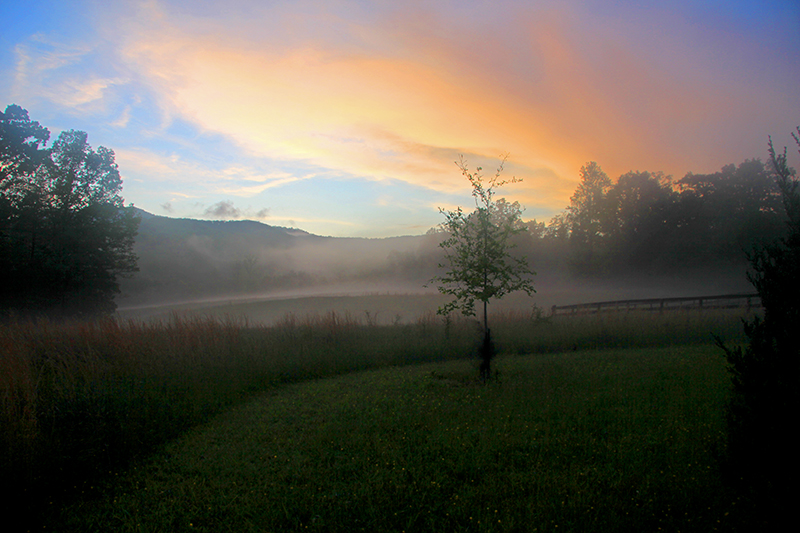May 31st, 2013 §
In all the rush of cleanup and planting and hosting house guests, I failed to report on what was blooming in the gardens in April and May. So here are a few of my favorite shots from the last two months. Now I can start fresh with June and hopefully do better with posting what’s blooming as it happens! Not only is that the more newsy approach, it also helps me keep a record of what happened when in the garden.
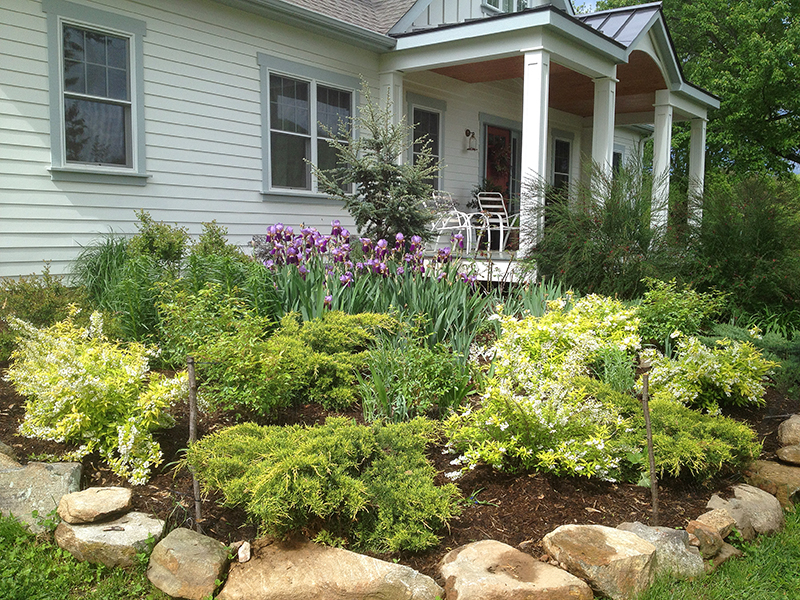
Purple irises, “All Gold” juniper, and “Chardonay Pearls” deutzia (with white flowers).
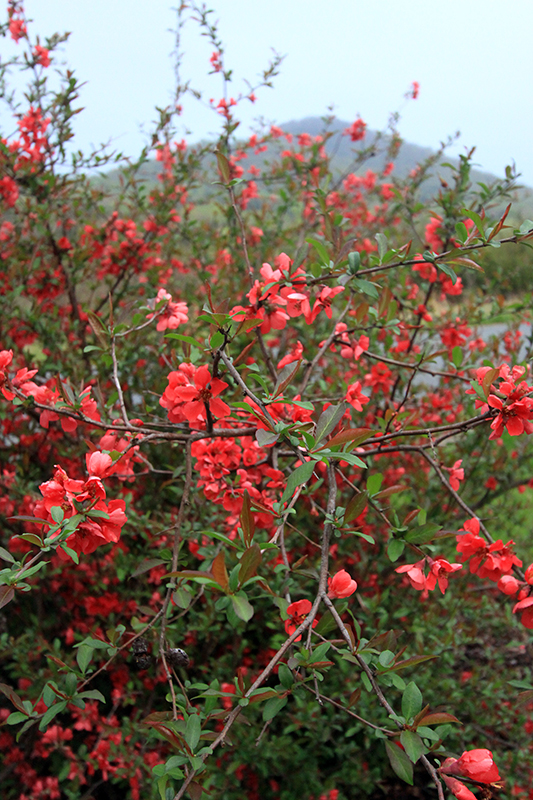
Quince by the mailbox. It bloomed beautifully this year, finally displaying the effects of four years of delicate rejuvenation pruning!
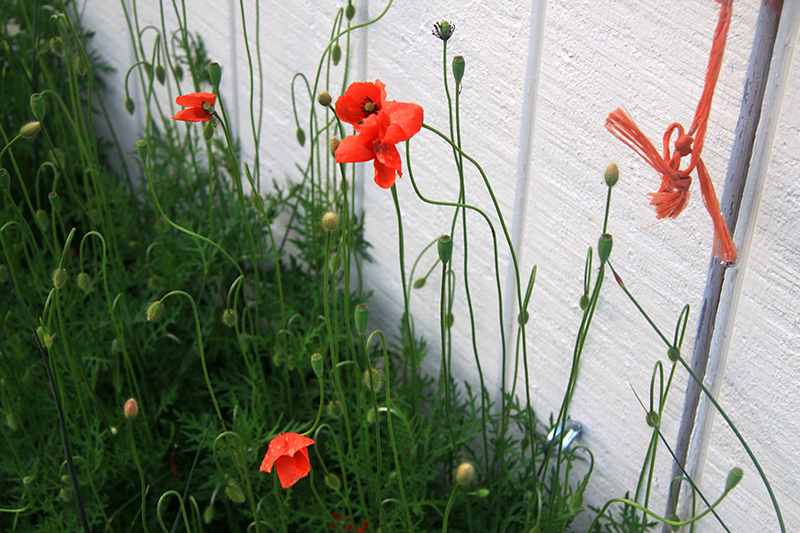
Volunteer poppies by the chicken coop. These appeared last year right by the clean out door—I have no idea where they came from. This year they really went nuts. I love how they match the baling twine.
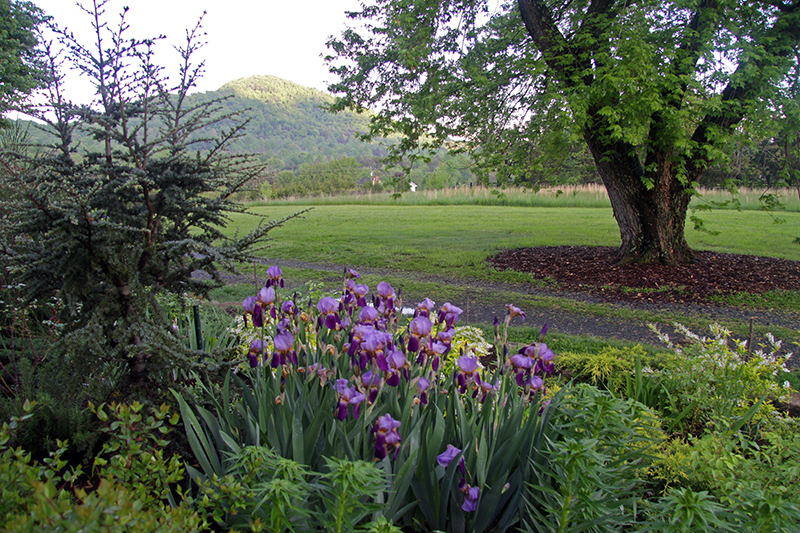
Buck mountain sunset over the front garden.
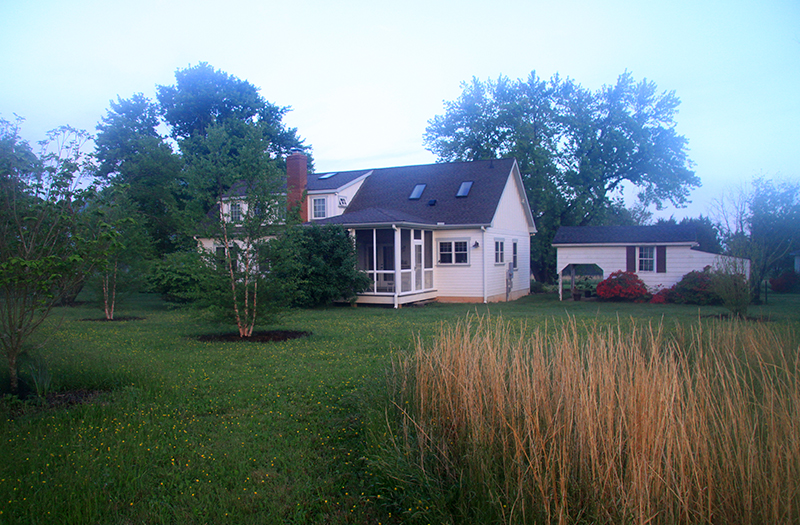
There was lots of grey, foggy weather in May.

Fallen flowers from one of my newer lilacs, “Declaration,” which is planted in the new forest. It was covered in blooms this year, unlike the old lilac by the porch and a newer bush, “Paul Thirion,” also planted in the new forest (which didn’t flower at all!)
May 30th, 2013 §
Ever since I moved to Bonafide Farm, I’ve wanted to grow hops. But the infrastructure always stopped me. Hops are vines (actually, botanically they are bines) that will grow 20′ or more, and need trellises that I just didn’t have the energy to conceive and build.
But in mid-April I was down in Nelson County, which is now regionally acclaimed for its breweries (Devil’s Backbone, Blue Mountain, etc.) enjoying a post-hike flight at Wild Wolf with some friends. A sign at a shop across the patio advertised hop rhizomes. I couldn’t resist. Turns out I had discovered HomebrewZ!, a delightful little shop stocking all your homebrew essentials.
A very lovely woman sold me her last seven Cascade rhizomes and instructed me to “go across the way” to speak with another woman who would impart all the secrets of hops culture to this neophyte. I got the skinny from this sage and rejoined my friends and our dogs on the patio.
The rhizomes,which are nothing more than 3-4″ twigs, languished in a paper bag until I could do a little research and make a trip to the hardware store for supplies. Then my friend Simon and I spent an evening hauling forest topsoil and compost to the site of an old berry patch by the south side of the garage. Once we had the soil nice and juicy (hops are heavy feeders with an extensive root system), I mounted the ladder, drill in hand.
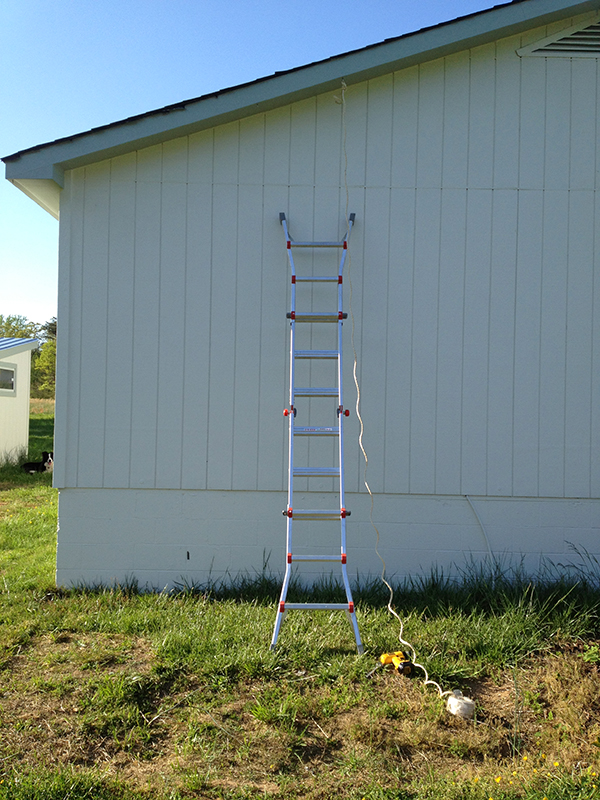
Right up under the eaves I installed two stainless steel eye-bolts. Then I ran 3/8″ sisal rope from them down to dog tie-outs that I’d screwed in to the growing bed. And this was the extent of my trellis system. One of the best things I have learned from living here is that sometimes things work out best when I am just pushed to react to what a situation demands, instead of obsessively planning to the point of inaction.

I arranged the rhizomes in the soil around each tie-out, covered them over, and hoped for the best.
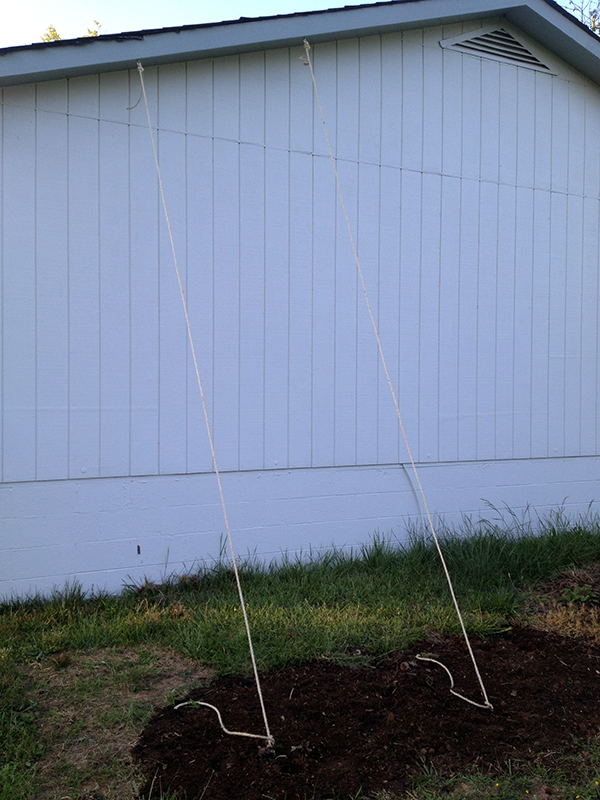
A few weeks passed with no change. Just as I began to worry that I’d gotten some dead rhizomes, tiny leaves appeared. And then there were more. I made chicken wire cages to keep the chickens from eating the hops, and in a few days more sprouts appeared. And then I went away to the beach for eight days, and when I returned my little hop babies had found their ropes and started to twine. So precocious!
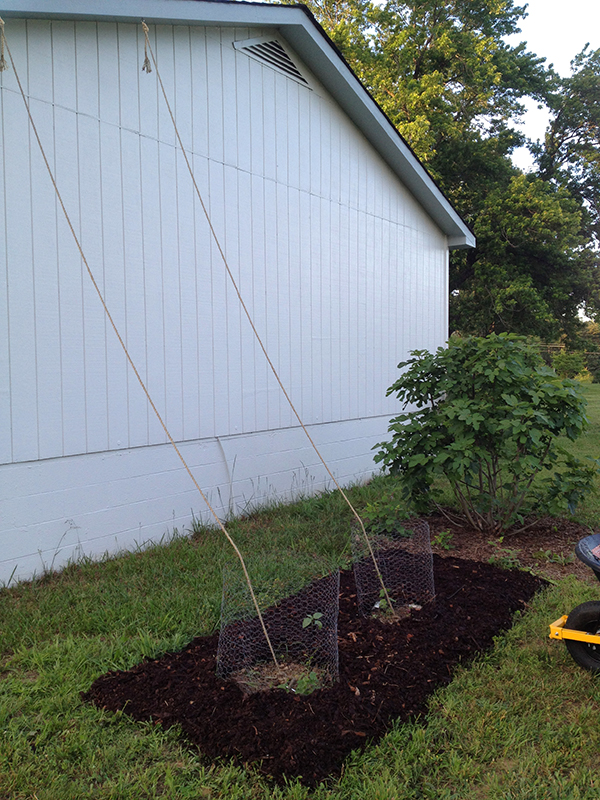
Unfortunately the pasture was fast overtaking this nice, rich new bed, so last weekend I dug out all the weeds, laid down newspaper, and piled mulch on top. This will keep the weed pressure off my hops so they can grow to their max. That’s my Celeste fig next to them, which came through this winter without any intervention from me and is on its way to becoming a beautiful asset.
I found another little snake in the mulch. This is the second “mulch snake” I’ve encountered.
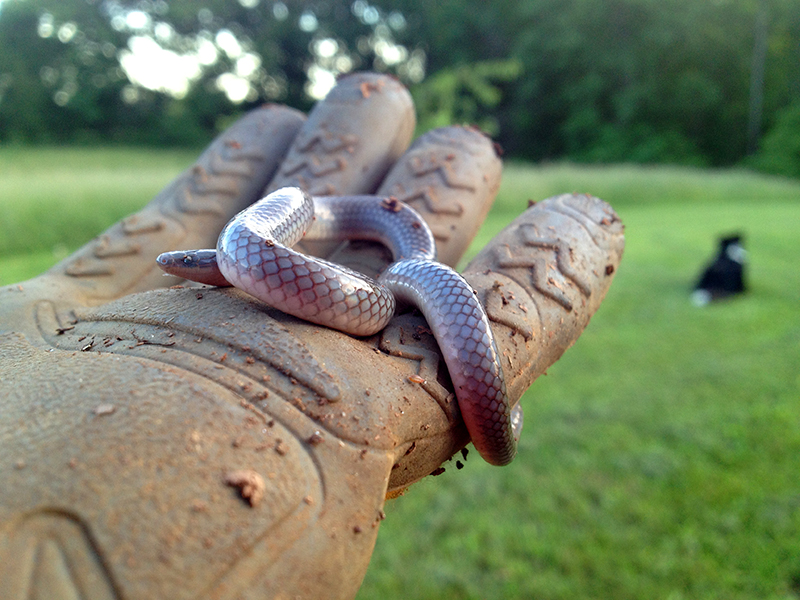
I placed him next to the growing hops. I figured twiney things belonged together.
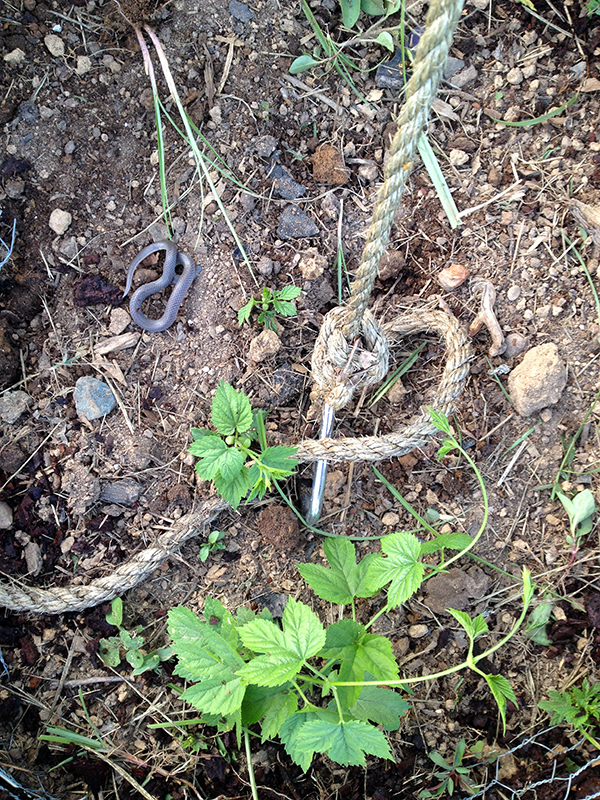
I am very excited to see what my hops do. Maybe someday I’ll be making a Bonafide Brew with my own homegrown hops! And if not, hops are a wonderful herbal sedative often used to induce sleep. A girl can dream…
May 29th, 2013 §
I stepped out on the front porch early this morning and what should I see but Cora, my once-scalped Wheaten Ameraucana hen, strutting across the front yard. That’s weird, I thought. Maybe I shut up the coop last night before she had a chance to get inside? But then, oh crap, I realized, I had totally forgotten to close the coop at sunset.
Cue the sick sinking feeling I was describing in yesterday’s post. Visions of a chicken massacre scene ran through my head, all red blood and multicolored feathers spattered in the coop. My entire flock dead and either dragged into the woods by the fox or eaten where they fell by the marauding raccoon or dog or whatever.
But just then the rest of the flock came strutting around the corner of the house, where I assume they had been enjoying their first uncooped sunrise. I did a quick, heart-in-throat scan, and found only one black chicken to be missing: Lilac.
I quickly recalculated the damage potential in my head. Losing Lilac would be, well, a loss, but she was one of my two oldest hens and her laying days were shorter than those of the younger birds. And then I remembered one important thing about Lilac: she’s my most consistent layer.
I ran to the coop, steeling myself for a possibly messy scene. But there was Lilac, hunkered in the nesting box, working on laying today’s egg. I have never been more relieved to see a hen on the nest.
All’s well that ends well, but I definitely messed up. I really lucked out last night that no birds were killed. I need to be a more vigilant chicken keeper, and I’m setting a daily close-the-coop phone alarm today!
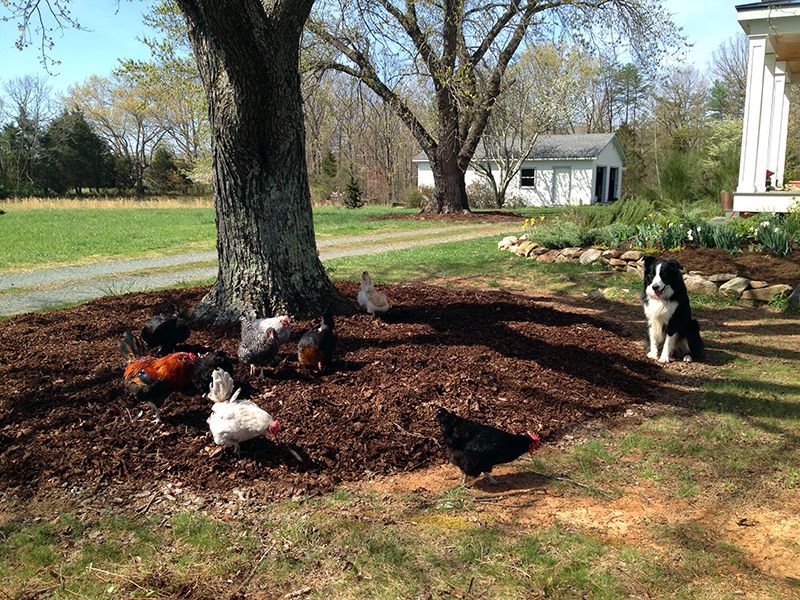
May 28th, 2013 §

What a busy Memorial Day Weekend!
On Saturday I visited a friend for a look inside his new beehive. We’d taken an into to beekeeping class together this spring, and he won the class drawing for a complete hive with bees. After taking the class I decided against adding bees to the farm this spring, figuring that the roughly $600 outlay to get started with two hives was too much at this time. Further, there are so many things that can go wrong with a bee colony, from diseases to pests to the vagaries of weather and wildlife, that I got nervous I would screw it up and didn’t want to add that stress right now.
However, after seeing Aaron’s beehive, I am totally smitten and kicking myself that, as usual, I over thought it and didn’t jump right in. With complete sincerity I have to say that opening that hive and seeing thousands of beautiful creatures busy creating their perfect home was one of the most miraculous things I have ever seen. The precision of each cell of honeycomb blows my mind, as does the order the bees demonstrate as they go about separating comb into areas to raise brood and store honey.
We added a super (outside box), fed the bees, and inspected each frame of the hive. I learned how to hold a bee-covered frame without dropping it or crushing any bees. We found the queen, distinguished by a red dot of paint on her back, busy in the lowest super. Through this whole experience the bees buzzed about around me and I didn’t feel scared once. I was wearing overalls, my wellies, and a borrowed bee jacket and veil, along with rubber kitchen gloves. I think this delicate armor helped to alleviate any fear of being stung, but I also felt entirely calm around the bees. An inner voice told me that calmer I was, the calmer the bees would be (which is a mindfulness technique I have learned from working with all sorts of animals), and it seemed to work. I just focused on assisting Aaron and my mind was entirely present. It was strangely meditative, actually, moving slowly and deliberately so as not to kill the bees or panic them.
If anything, I’d get a beehive just to feel that peacefulness again. But I have been doing this farm thing long enough to know that the flip side of that wonderful feeling is the sadness that comes when living things in my care get sick, or injured, or fail to thrive.
I spent Sunday working in the garden, planting out a bunch of plants that Aaron sent home with me. I also fabricated more than twenty dahlia supports from 42″ tomato cages. I cut the legs off each cage, bent those wires into u-pins, and brought them to the garden, where I secured them, upside-down for stability, over the more than twenty dahlias that I planted out. I had started these dahlias in pots, some as early as March and others in April, hoping to get earlier blooms than usual. We’ll see if it works. Regardless, I will have very neatly supported plants!
I’ve also been busy tucking zinnia seeds around the house garden, and minding the blossoming veg garden. Lots going on—the growing season is upon us and I can be outside from morning until sunset and not run out of things that need tending.
Then on Memorial Day I went to a cookout hosted by new master gardener friends. When I got home, around 8:30 p.m., I bottled the beer that I made when my friends Brad (my homebrew mentor) and Amy visited in early May.
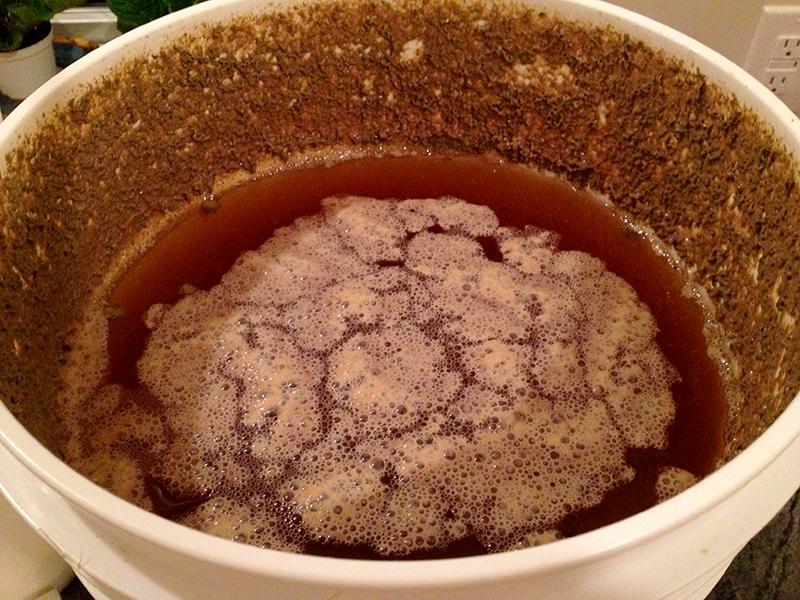
It’s a kölsch, a nice summer sipper, and I am pretty excited about it. I was nervous as the top blew off the fermenter its first day out, but that didn’t seem to negatively affect the beer.
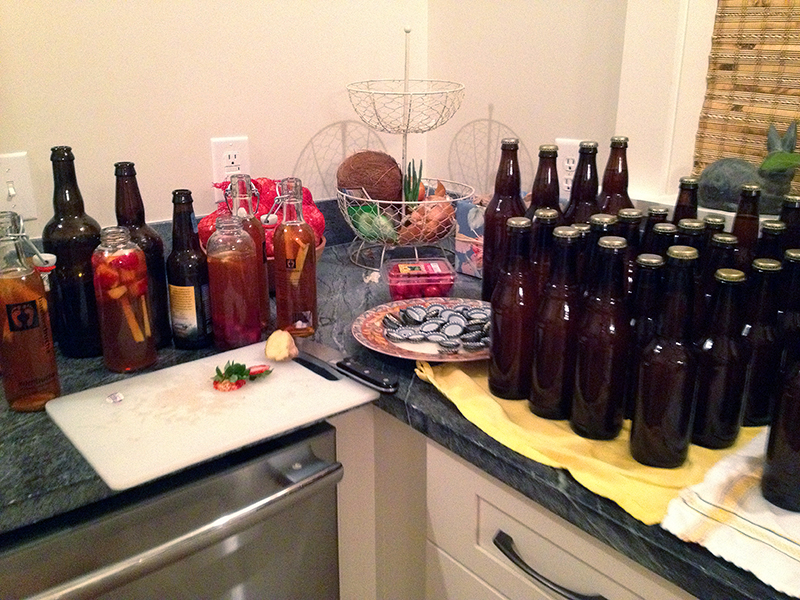
As the kitchen was already a mess, I went ahead and bottled up some of my kombucha. This is the first batch I have made in four years, and it’s delicious. I spiked a few bottles with ginger, cherries and strawberries for a secondary fermentation. And then at nearly midnight I started soaking some wheatgrass seeds, which is a new experiment. I plan to grow them out to add to my green juices.
And so things continue on: growing or not growing, fermenting, decomposing or dying. It’s all happening here, all around me.
May 14th, 2013 §
The average last frost date in Free Union usually occurs between April 11 and 20. This year, however, we’ve had a cool, long spring, and last night were hit with what I suspect will be our last frost of the year.
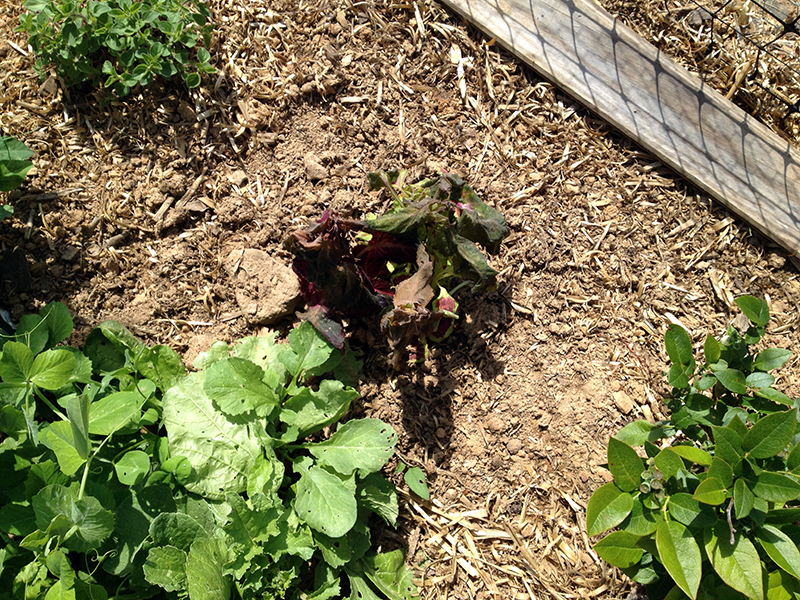
My only frost victims in the veg garden were a couple of coleus I’d stuck in over the weekend. I like to grow coleus to add to cut flower bouquets. There are the dead plants above, nestled among some oregano, radishes, peas, and a blueberry bush—all of which made it through the night just fine.
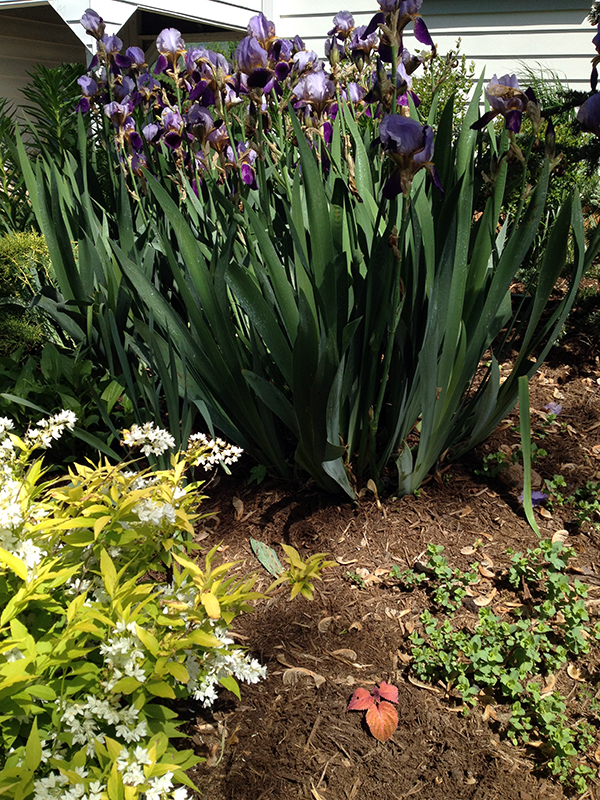
Interestingly, the even smaller coleus starts—above, in red—I’d stuck around the house garden escaped frost damage. Of course it makes sense that the south side of the house would be warmer than the exposed garden out in the field, but I continue to enjoy discovering all the different microclimates on this property.
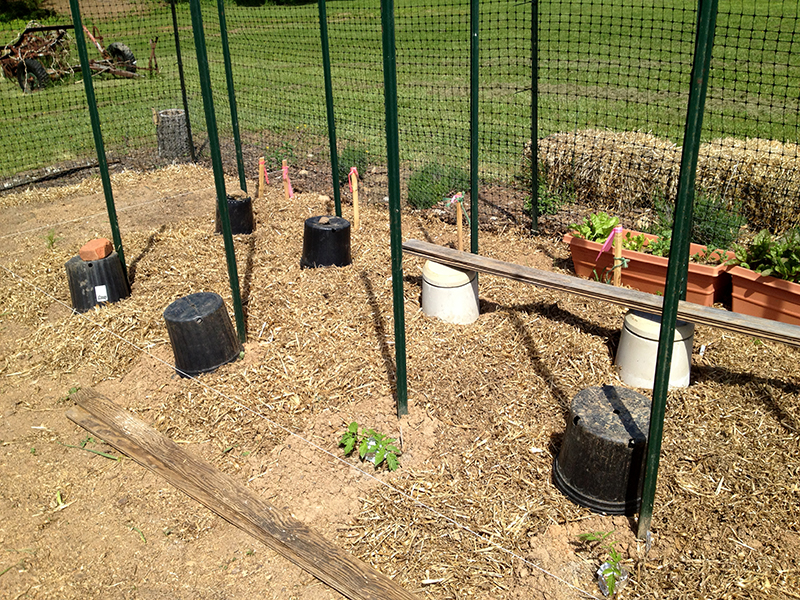
Of course I covered the new tomatoes for the night, and they were okay, as were all the pots of started dahlias and other vegetables I stashed in the well house overnight. I wonder how the local vineyards and orchards and other farmers fared—I read news stories last evening that it was going to be a stressful night as many growers watched the mercury with their livelihood on the line.
Looking at the upcoming forecast, in which temperatures are supposed to shoot up to near 90 degrees tomorrow, I am just going to go ahead and call it. Winter is over, let the (frost-free) growing season begin!
May 12th, 2013 §
May 10th, 2013 §
No matter how I try, within days of clearing off every surface of my house things start to accumulate. And not just any things. Usually they’re living, dirt-covered or maybe even sporting a smidge of chicken poop. Sometimes they’re fermenting, in both good and bad ways.
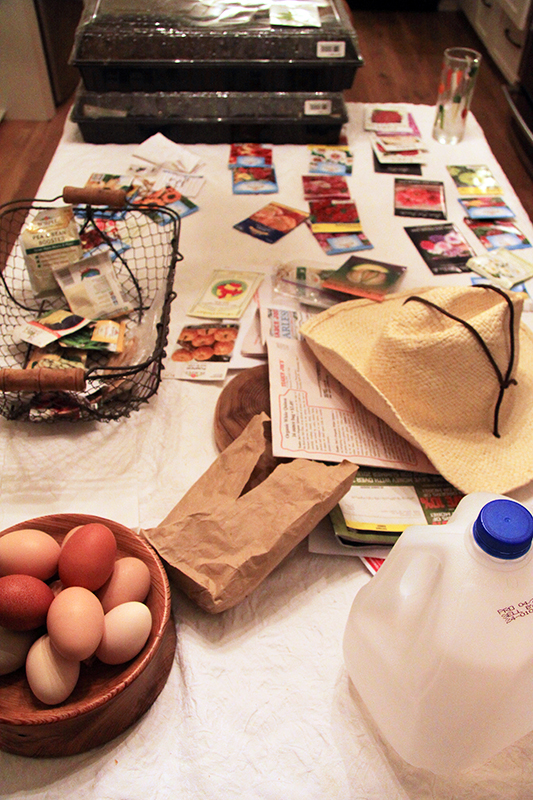
Case in point: my kitchen table right now. I’ve been puzzling out my vegetable/cutting garden plan for days, laying seed packets out like playing cards. A game of solitaire, this is. I’ve also got a few flats of recent experiments: lavender seeds left over from 2011 that I never got around to and the mother of all herbs, Urtica dioica, or stinging nettle. Yes, call me crazy but I am trying to grow that hiker’s bane from seed, hoping to transplant nettle down in the woods by the creek. I was shocked to not find any natively growing here, and as a source of minerals, nutrition and herbal healing it’s too important to live without.
And there’s a jug of spring water left over from Sunday’s homebrew session (which on Monday exploded all over my guest room, as in, I actually had to scrub my ceiling!) And a nice little collection of recent eggs that I am on the fence about refrigerating, thinking I may offer them to a new friend with a broody hen. I’d love it if one of my hens went broody, as I am dying to see what sort of crosses I’d get from my various hens and my Wheaten Ameraucana rooster. I had given myself the parameter that any new chicks would have to be hatched and raised by one of my existing hens, to cut down on labor, mess, and potential flock integration trauma, but with that gorgeous stack of potential just sitting there I am this close to getting an incubator. As if I need another project!
This doesn’t even show the kitchen counter, which is busy nurturing young plant starts and soaking morning glory seeds for planting out tomorrow. And I have a new pet—a kombucha scoby fermenting on the windowsill, waiting to be released into a jug of sweet tea.
As much as not having clear surfaces makes the Virgo in me a bit panicky, I also love living surrounded by my various projects. I recognize that this sort of “mess” is bound to accompany me wherever I go, and it will ebb and flow with the growing seasons and whatever else I am up to. My house smells like moist potting soil and lilac, fermenting beer and wood smoke, mulch-covered dog and iris. It smells alive, and as long as nothing’s putrid I rejoice in this perfume. There’s always January for empty surfaces and clear spaces.
May 10th, 2013 §
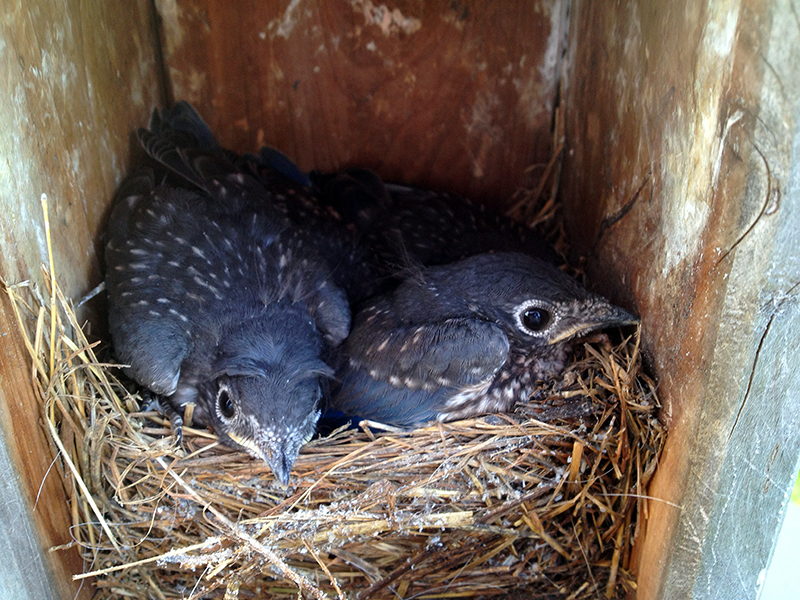
I have confirmed that all five bluebird eggs have transmogrified into five almost-fledged bluebird babies. After years of minimal success in the bluebird box, this is a joy to behold. Of course, a big test is yet to come: fledging.
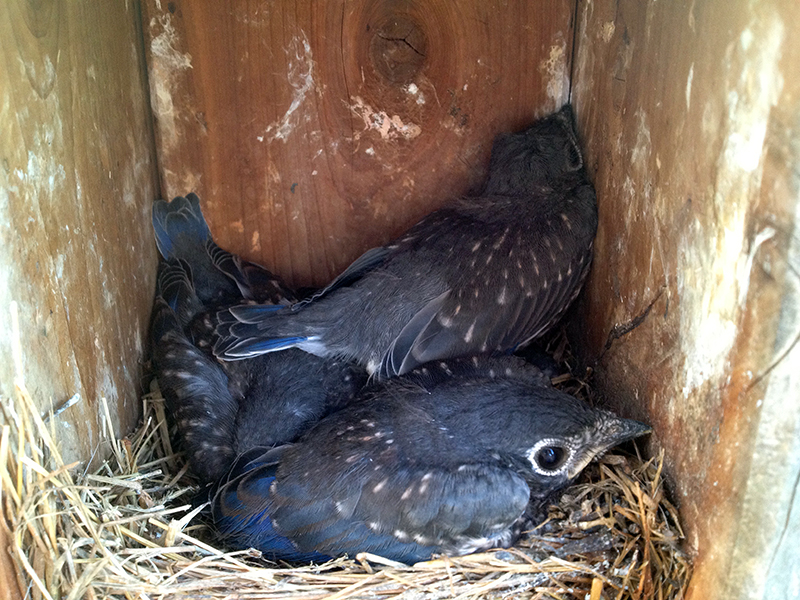
Last night when I opened the box, one fledgling let out a squawk as it repositioned deeper in the box. Hearing his progeny sound this warning greatly displeased Mr. Bluebird, who loudly scolded me from a nearby tree. I shut the box and beat a hasty retreat.
Based on the tail feather growth I see here, I suspect fledging at any moment. I will be watching, hoping to catch the great leaps!
May 9th, 2013 §
Brood II of the 17-year perennial cicadas has arrived! Last night I found this big guy in the woods sitting on a clump of irises and daffodils. I didn’t think the soil temp is up to 64 degrees at 8″ yet. I suspect some cicadas might have been driven out of the ground by the several inches of rain that’s fallen in the last few days. Still no deafening trill outside—that’s yet to come.
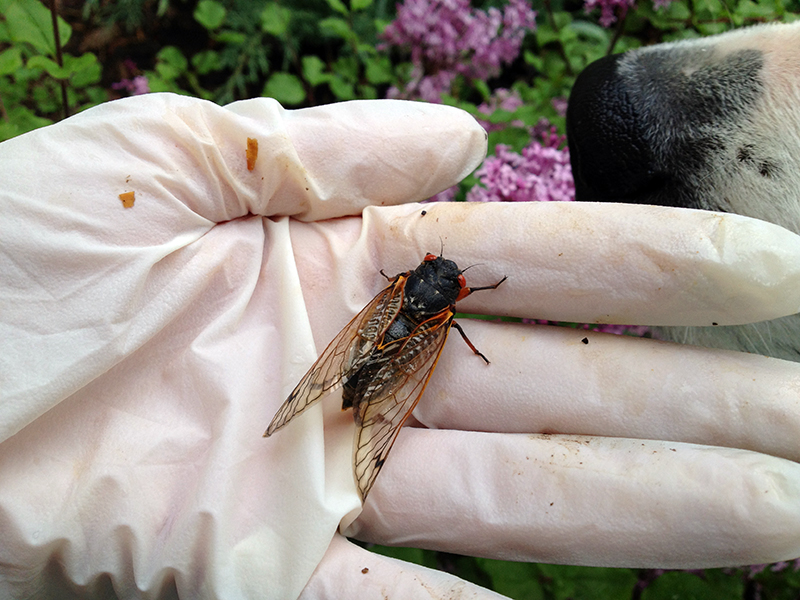
Please excuse the creepy latex glove. I don’t normally walk around sheathed in plastic, it’s just that I sliced my finger open Sunday night and wanted to keep dirt—and cicada legs—out of the wound.
May 9th, 2013 §
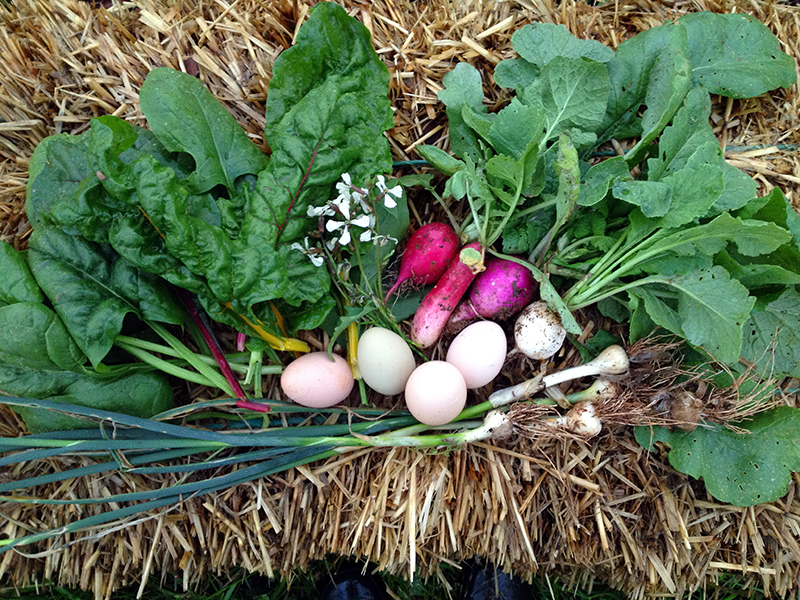
We’re in it now, thank goodness, the season when dinner is picked straight from the garden. Tonight’s salad will be spinach and Swiss chard, both overwintered, and this year’s first radishes along with some wild onions growing around the garden fence. I’ve never eaten wild onions, but they grew tall and lusty while my seeded spring onions failed to thrive, so I sliced them up tonight when I composed my salad. The onions have a very delicious, pungent flavor that I can only describe as “wild lawn-like.” They tastes like the smell of a freshly mown pasture. They may overpower the salad, but I stacked their flavor against a hefty homemade balsamic and dijon dressing and we will see where it goes. The greens were a bit sturdy so they’re all getting happy in the dressing, wilting a bit before I dig in.
And of course, today’s eggs are in there along with some arugula flowers, which are a beautiful, peppery garnish. All together, this would make a slamming fritatta. And not only does this feed me—the radish and onion tops, chard stems and egg shells go straight to the compost, where they feed the worms that enrich the soil that goes back in the garden. A closed system, and a beautiful one.
You may note the slug on the chard leaf. We’ve had two days of rain and the slugs are out in force. You may either eat or discard the slug when you make your own version of this salad!




















